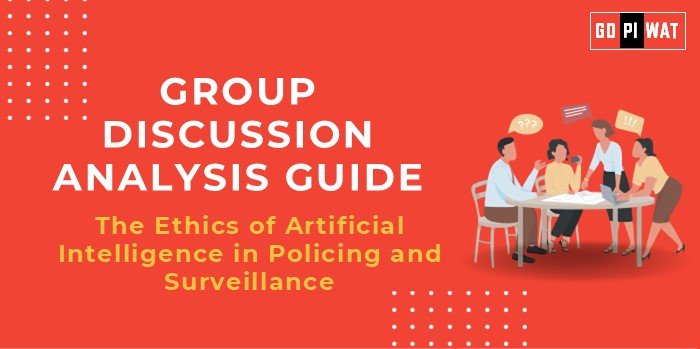📋 Group Discussion Analysis Guide: The Ethics of Artificial Intelligence in Policing and Surveillance
🌐 Introduction to the Ethics of AI in Policing and Surveillance
- 🔍 Opening Context: The rapid integration of artificial intelligence (AI) into policing and surveillance has transformed law enforcement globally. However, it has also sparked debates on ethics, privacy, and fairness, making it a crucial topic for future leaders.
- 📖 Topic Background: AI technologies like facial recognition and predictive analytics are increasingly used to monitor public spaces, predict crimes, and identify suspects. These innovations, while powerful, often face ethical concerns regarding bias, misuse, and overreach.
📊 Quick Facts and Key Statistics
– 🌍 Global AI Policing Market: Estimated to reach $19.6 billion by 2025, showcasing the rapid adoption of AI in law enforcement.
– 🤖 Facial Recognition Accuracy: Studies reveal an error rate of up to 35% for certain ethnic groups, underscoring ethical concerns.
– 📹 Surveillance Cameras: Over 1 billion globally, with AI integration increasing year by year.
– ⚖️ Bias in AI: A 2022 report by MIT found racial and gender bias in 85% of AI surveillance tools tested.
– 🤖 Facial Recognition Accuracy: Studies reveal an error rate of up to 35% for certain ethnic groups, underscoring ethical concerns.
– 📹 Surveillance Cameras: Over 1 billion globally, with AI integration increasing year by year.
– ⚖️ Bias in AI: A 2022 report by MIT found racial and gender bias in 85% of AI surveillance tools tested.
🤝 Stakeholders and Their Roles
- ⚖️ Government Agencies: Deploy AI for law enforcement and public safety.
- 💻 Technology Firms: Develop and refine AI surveillance systems.
- 📢 Civil Rights Organizations: Advocate against potential misuse and for robust ethical standards.
- 👥 General Public: Directly impacted by surveillance practices and AI-based policing.
🏆 Achievements and Challenges
✨ Achievements:
- ⚡ Crime Prediction and Reduction: Cities using AI saw up to a 15% drop in crime rates.
- ⏱️ Efficient Policing: AI-powered tools reduce investigation time by 30-50%.
- 🔍 Missing Persons Tracking: Facial recognition helps recover missing children in countries like India and China.
⚠️ Challenges:
- ⚖️ Bias and Discrimination: AI systems have been shown to disproportionately misidentify minority groups.
- 🔒 Privacy Erosion: Extensive surveillance raises questions about citizen freedoms.
- 📜 Misuse by Authoritarian Regimes: AI tools are often weaponized against dissenters.
🌍 Global Comparisons:
– China: Extensive AI surveillance with minimal privacy safeguards.
– EU: Stronger regulations under GDPR limit AI misuse.
📌 Case Studies:
– India: Deployment of AI cameras in Hyderabad; concerns over accuracy and privacy.
– US: Predictive policing in Chicago criticized for reinforcing systemic biases.
🧠 Structured Arguments for Discussion
- ✅ Supporting Stance: “AI enhances policing efficiency, reduces crime rates, and aids in saving lives.”
- ❌ Opposing Stance: “AI in policing perpetuates bias, violates privacy, and erodes civil liberties.”
- ⚖️ Balanced Perspective: “While AI offers undeniable benefits in crime reduction, addressing its ethical implications is imperative.”
🎯 Effective Discussion Approaches
- 📜 Opening Approaches:
- 📈 Statistical Opening: “With over 1 billion surveillance cameras globally, ethical AI use in policing is a pressing concern.”
- 📌 Case Study Mention: “The inaccuracies in facial recognition during the 2020 US protests highlight the ethical risks of AI policing.”
- 🔍 Counter-Argument Handling:
- Acknowledge benefits but pivot to ethical safeguards.
- Use global examples of AI misuse to strengthen arguments.
🔍 Strategic Analysis of Strengths and Weaknesses
- 💪 Strengths: Crime reduction, rapid identification, data processing efficiency.
- ⚠️ Weaknesses: Algorithmic bias, potential misuse, data privacy concerns.
- 🚀 Opportunities: Ethical AI frameworks, public-private partnerships for fairness.
- ⚡ Threats: Public distrust, misuse in authoritarian contexts.
🎓 Connecting with B-School Applications
- 🌟 Real-World Applications: AI ethics as part of CSR initiatives or leadership courses.
- ❓ Sample Interview Questions:
- “Should AI be limited in law enforcement, and why?”
- “How would you balance innovation with ethics in a business environment?”
- 💡 Insights for B-School Students:
- Understand ethical dilemmas in tech.
- Explore AI governance frameworks.


